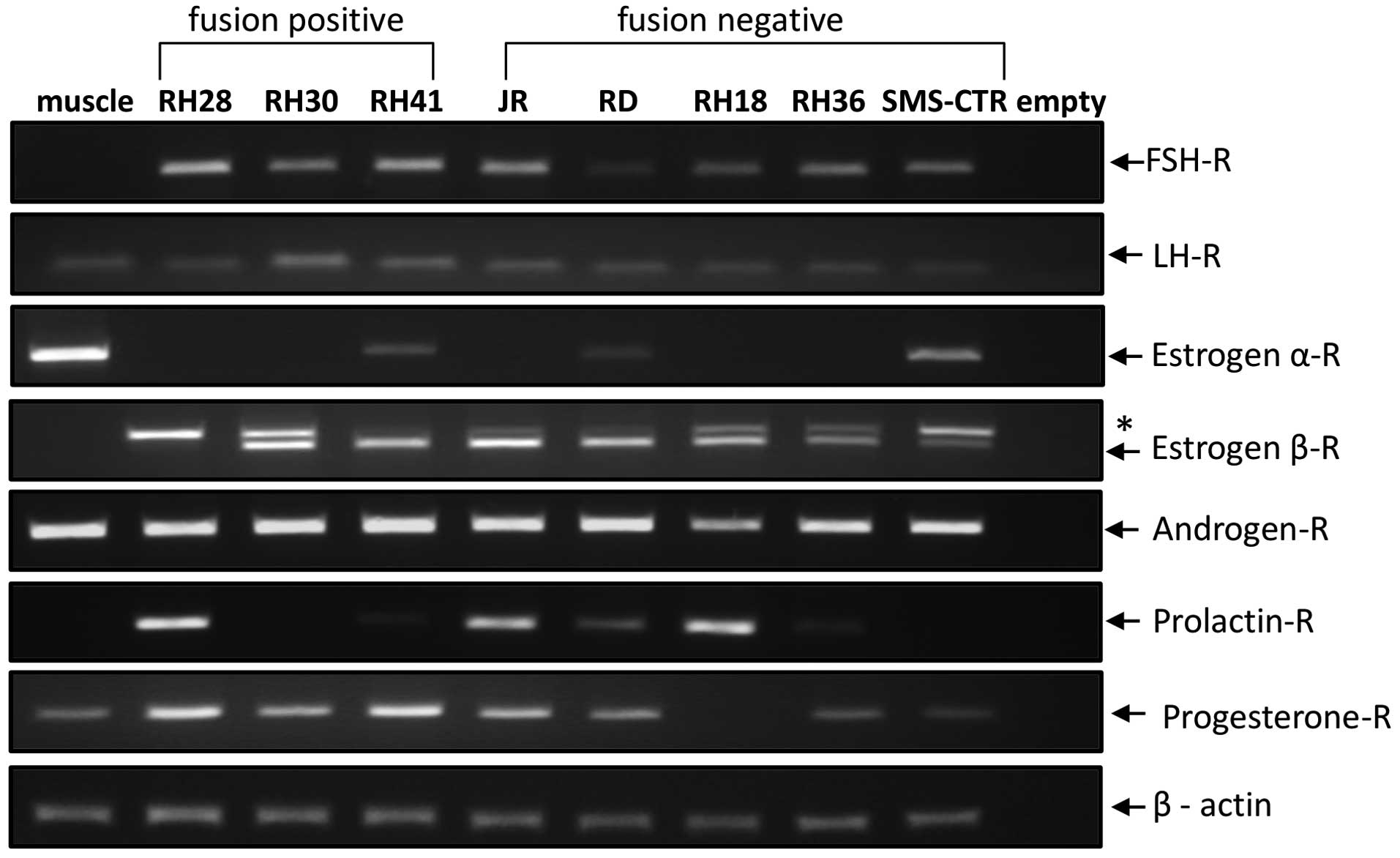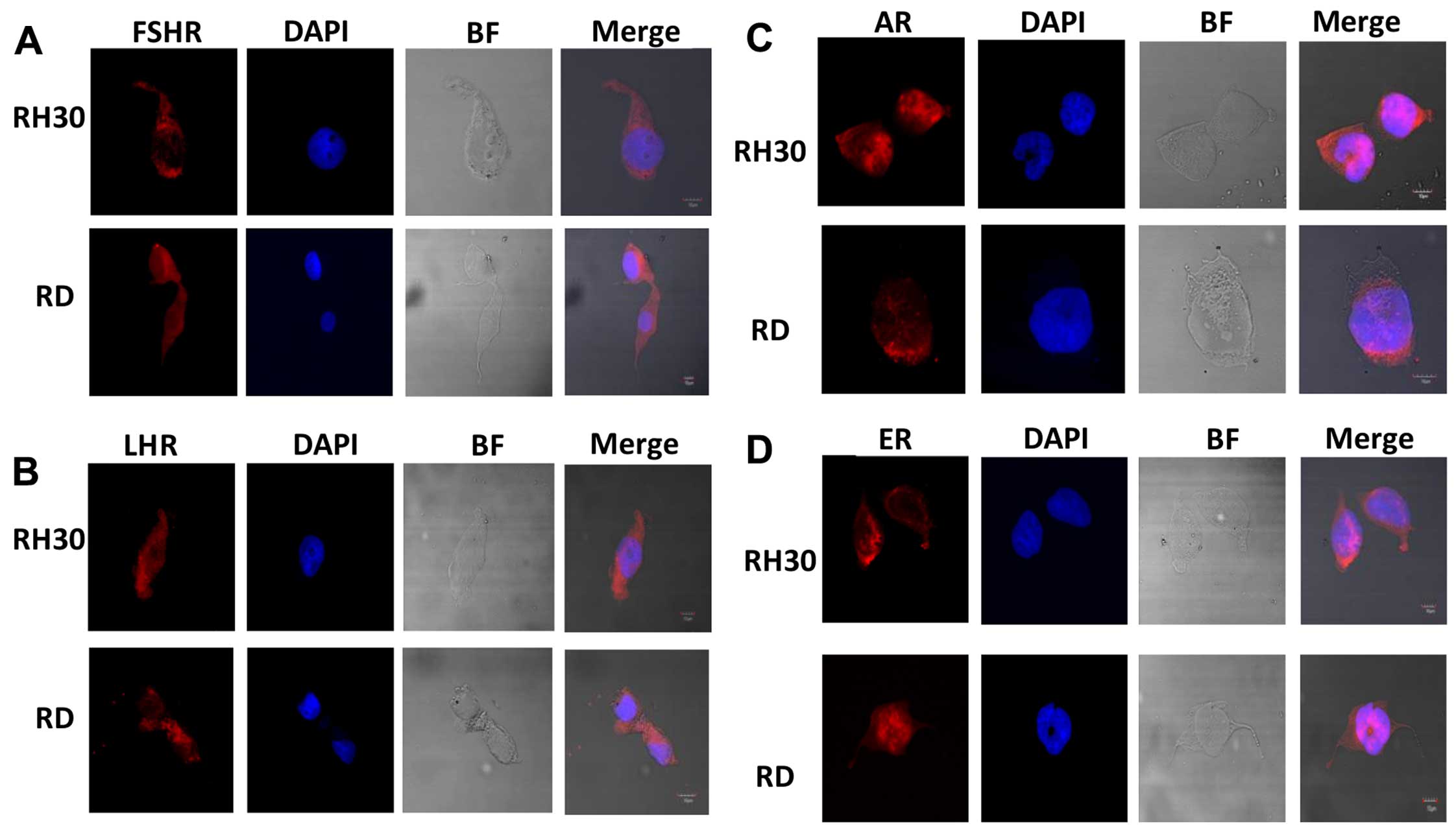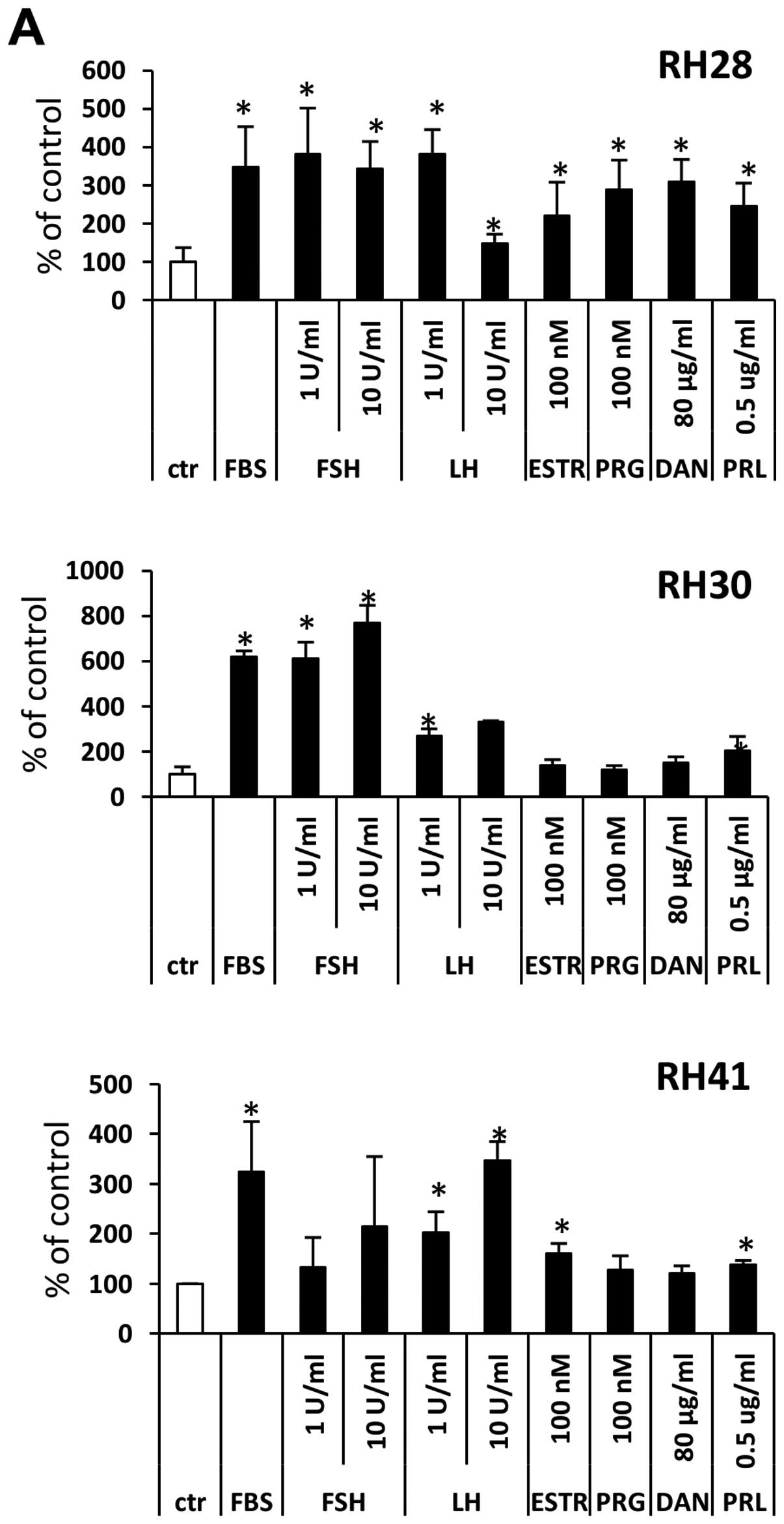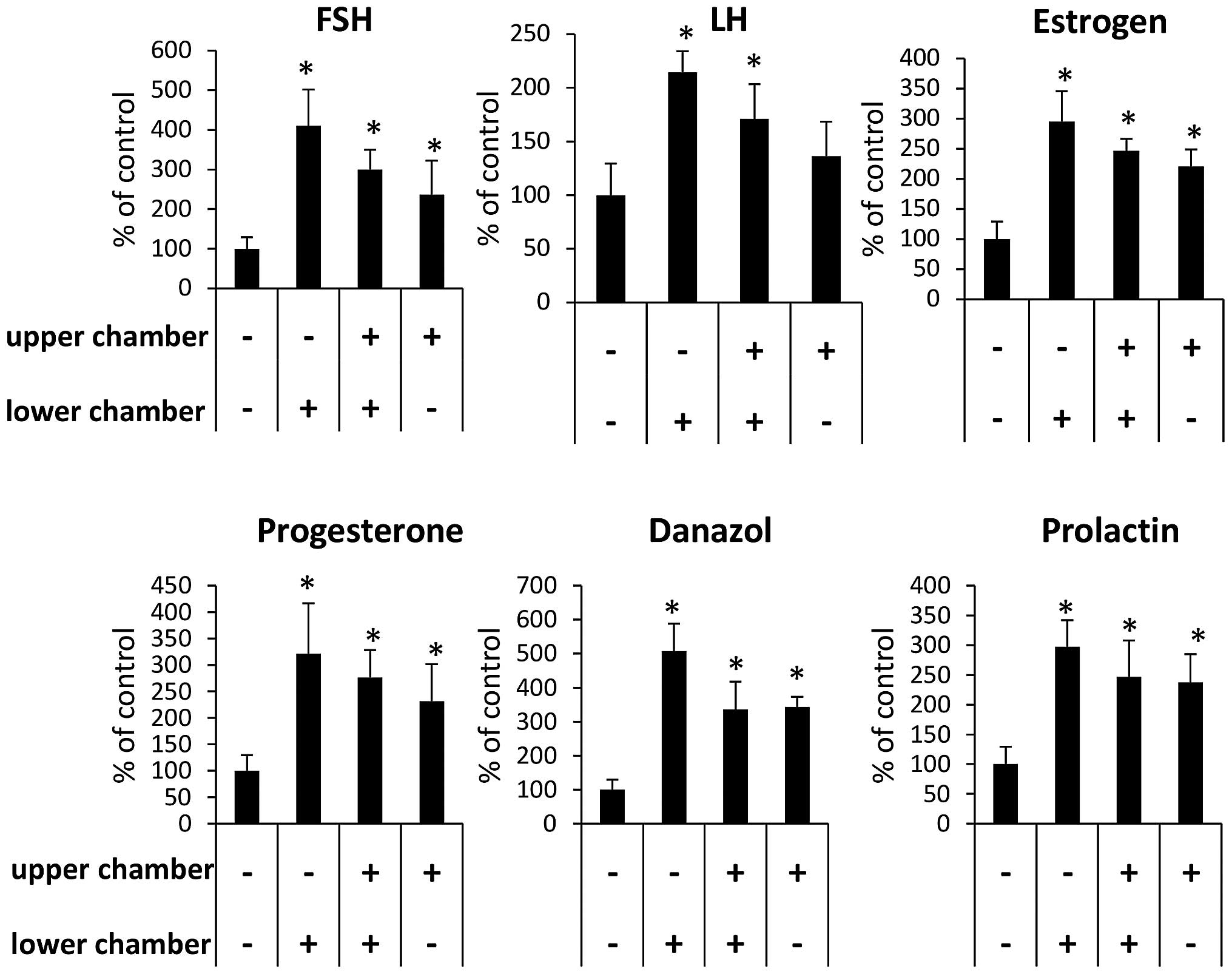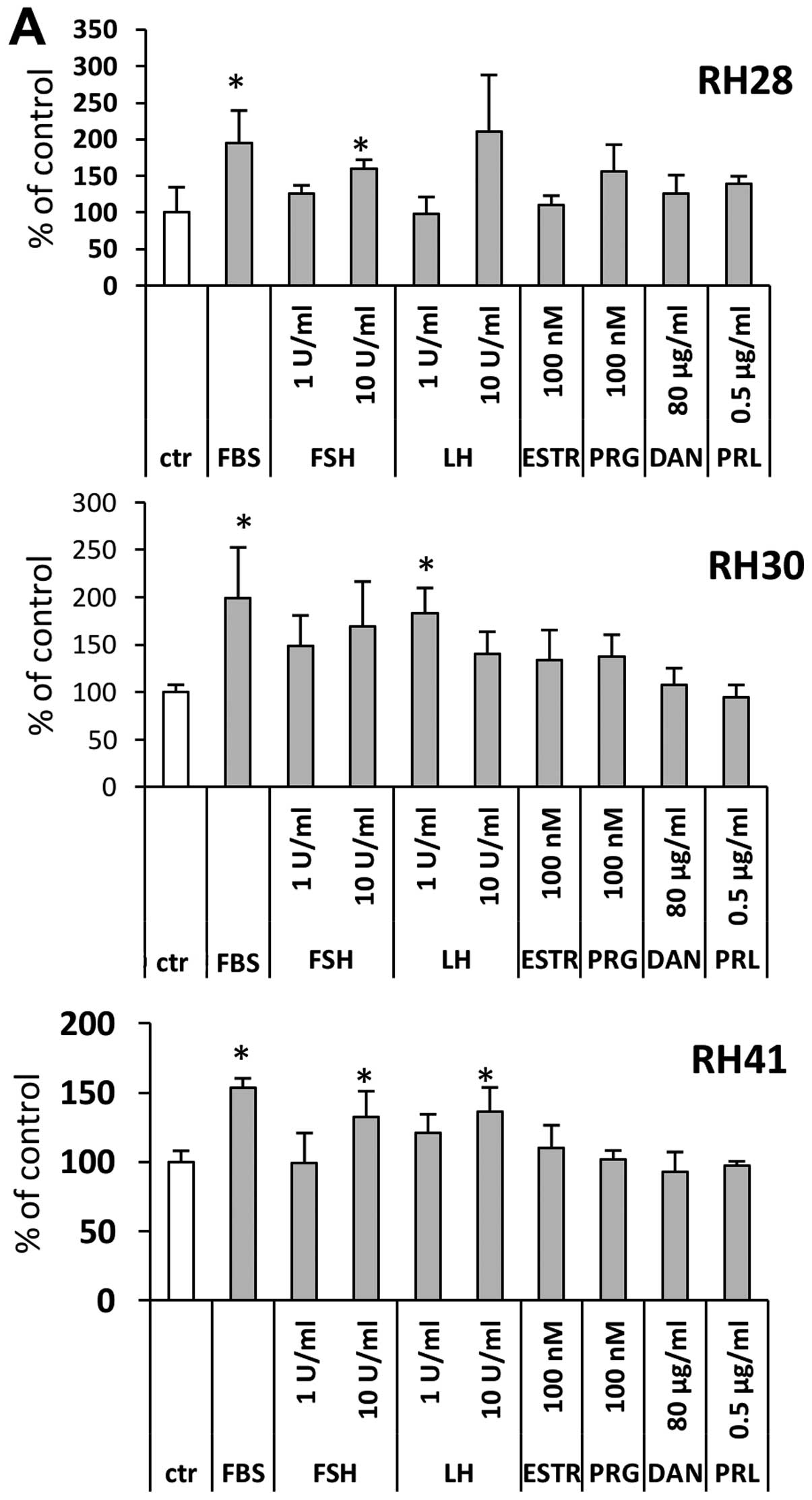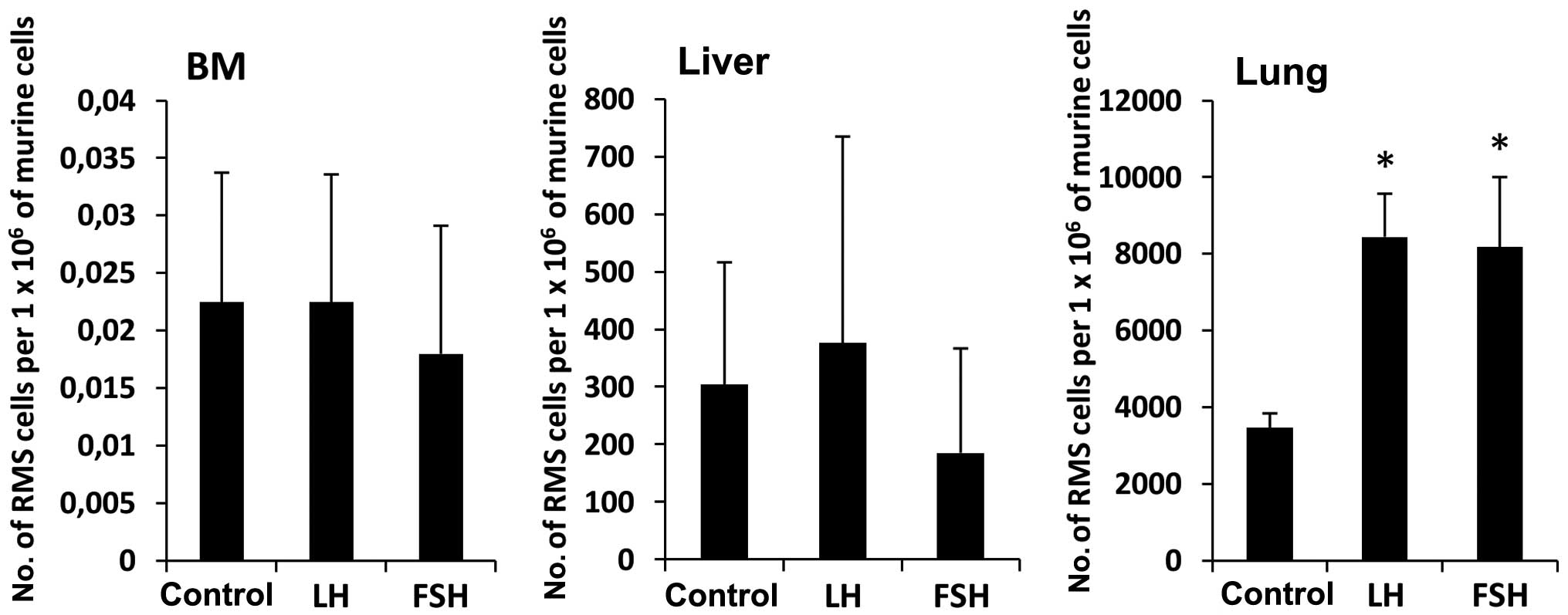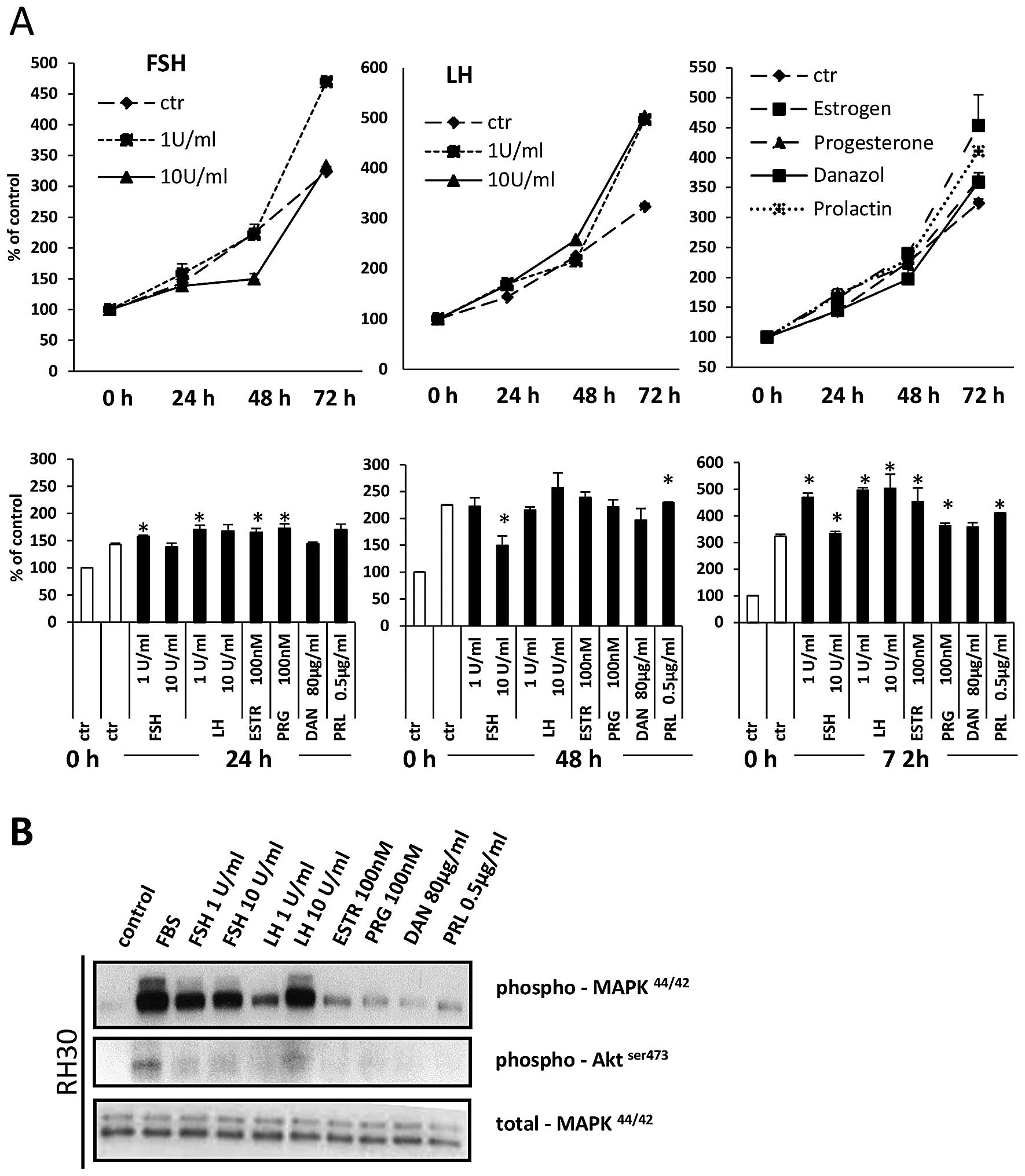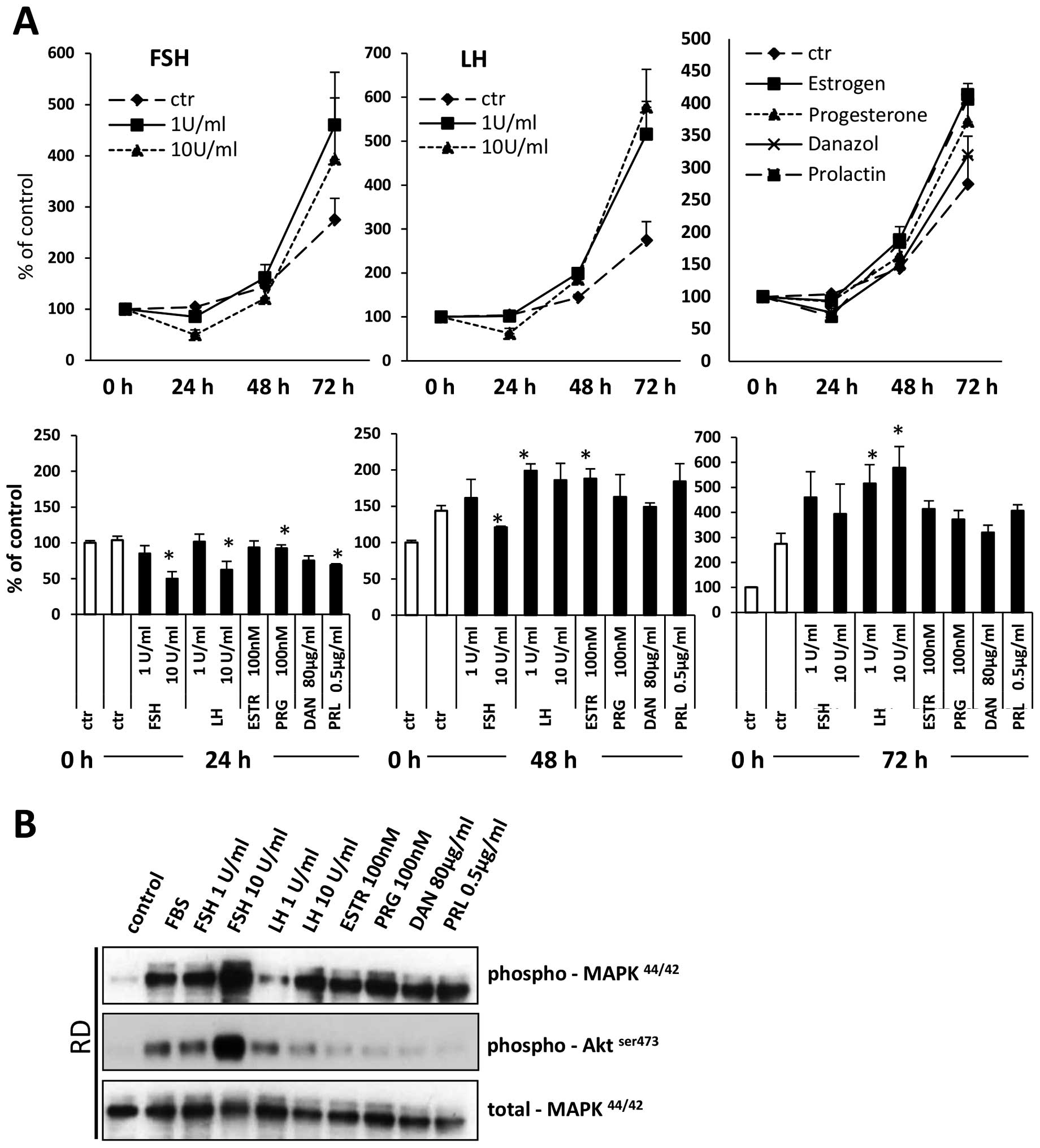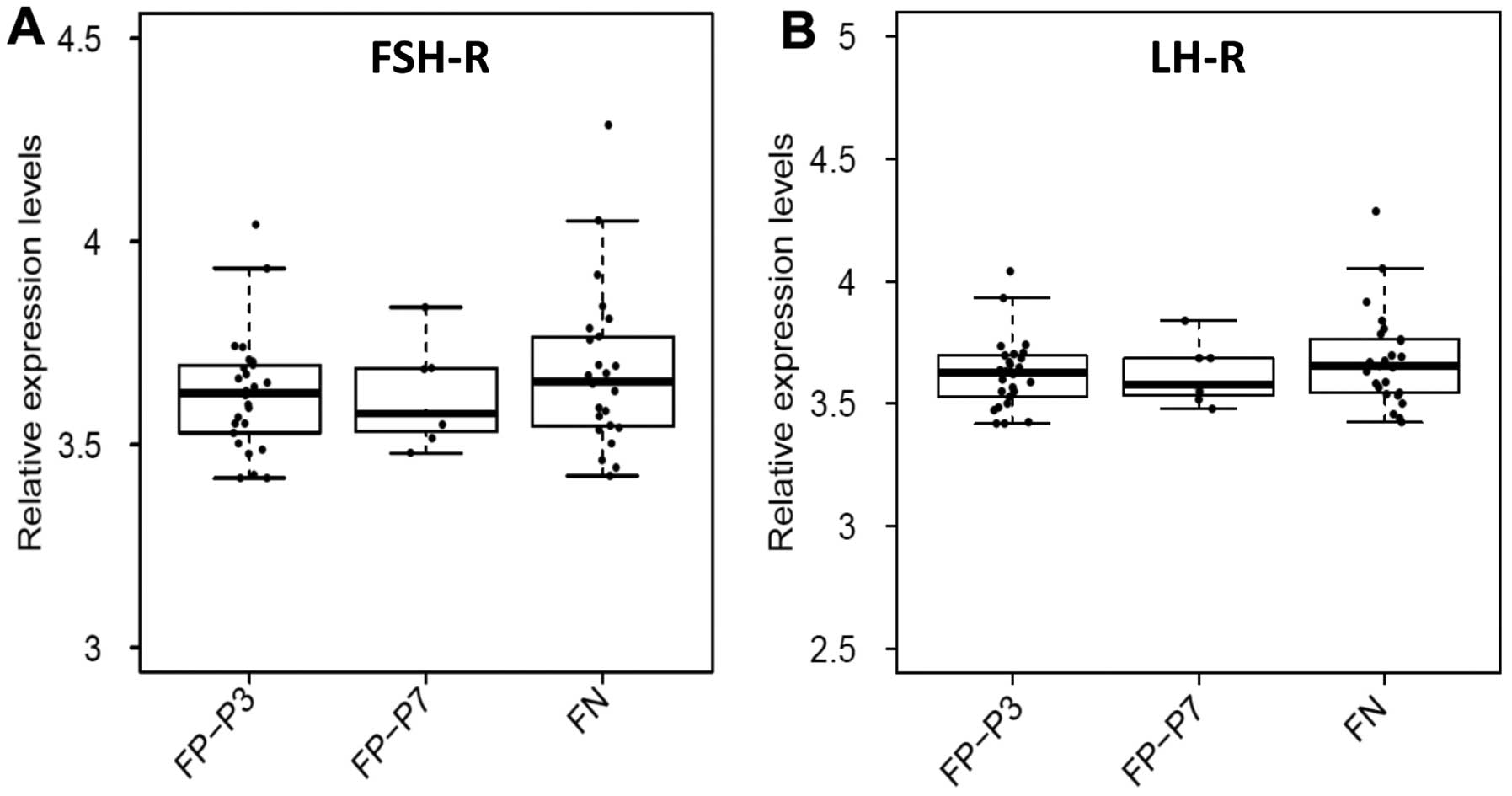Human rhabdomyosarcoma cells express functional pituitary and gonadal sex hormone receptors: Therapeutic implications
- Authors:
- Published online on: March 11, 2016 https://doi.org/10.3892/ijo.2016.3439
- Pages: 1815-1824
-
Copyright: © Poniewierska-Baran et al. This is an open access article distributed under the terms of Creative Commons Attribution License.
Abstract
Introduction
Rhabdomyosarcoma (RMS) is the most common soft-tissue sarcoma of adolescence and childhood and as reported accounts for 5% of all malignant tumors in patients under 15 years of age (1,2). It occurs also in older patients, and the median age at diagnosis for all 2,600 analyzed RMS cases (birth through 96 years) was 16 years (3). RMS belongs to the family of so-called ‘small round blue tumor cells’, which often infiltrate bone marrow (BM) and on BM smears may sometimes be misdiagnosed as acute leukemia cells (4). There are two major histological subtypes of this tumor: alveolar rhabdomyosarcoma (ARMS) and embryonal rhabdomyosarcoma (ERMS). ARMS is associated with more aggressive behavior and a worse prognosis than ERMS (5).
At the molecular level, ARMS is characterized by the t(2;13)(q35;q14) translocation in 70% of cases and the variant t(1;13)(p36;q14) in a smaller percentage of cases (6). These translocations disrupt the PAX3 and PAX7 genes on chromosomes 2 and 1, respectively, and the FOXO1 gene on chromosome 13, generating PAX3-FOXO1 and PAX7-FOXO1 fusion genes. The resulting fusion proteins, PAX3-FOXO1 and PAX7-FOXO1, have enhanced transcriptional activity compared with wild-type PAX3 and PAX7 and are postulated to play a role in cell survival and dysregulation of the cell cycle in ARMS (7). Since there are also ARMS cases that are fusion-negative and have a better outcome than ARMS cases that are fusion-negative, it has recently been proposed that RMS be classified into fusion-positive (PAX3-FOXO1 and PAX7-FOXO1) and fusion-negative tumors (8).
Both pituitary peptide- and gonadal steroid-based sex hormones play an important role in normal development and tumorigenesis and, thus, we were interested in the role of sex hormones in RMS pathogenesis. First, it is well known that these hormones are involved in both developmental growth and regeneration of skeletal muscles (9–11). For example, skeletal muscle satellite stem cells respond to stimulation by estrogens and androgens (9,12). Second, pediatric sarcomas, including RMS, share several common markers with the germ line-derived cells. For example, RMS cells express several cancer testis antigens (CTAs) (13,14). Moreover, changes in expression of parentally imprinted genes (e.g, Igf2-H19, Dlk1-Meg3 and p57KIP2) are involved in the pathogenesis of both pediatric sarcomas and germline tumors (15–17). Notably, 150 years ago, Virchow (18) and Conheim (19) proposed the so-called ‘embryonic rest’ hypothesis of cancer development, in which malignancies may develop from dormant development early embryonic cells or perhaps cells endowed with germ line potential residing in adult tissues. Small round blue cell tumors, including RMS, are potential candidates for such malignancies. Interestingly, a recent report demonstrated that the PAX7 gene, which plays an important role in skeletal muscle development, is one of the stem cell markers in germ cells in gonads (20).
We report here that several sex hormone receptors are indeed expressed by RMS cells. Moreover, we demonstrate for the first time that follicle-stimulating hormone (FSH) and luteinizing hormone (LH) receptors are expressed in established human RMS cell lines and, even more importantly, in primary tumor samples isolated from patients. We also found that several human RMS cell lines respond to pituitary and gonadal sex hormone stimulation by enhanced proliferation, chemotaxis, cell adhesion and phosphorylation of MAPKp42/44 and AKT. We conclude that sex hormones are involved in the pathogenesis and progression of RMS, and their therapeutic application should be avoided in patients with RMS.
Materials and methods
Cell lines
We used several human RMS cell lines (provided by Dr Peter Houghton, Nationwide Children's Cancer Center, Columbus, OH, USA), including both fusion-positive (RH28, RH30 and RH41) and fusion-negative (JR, RD, RH18, RH36 and SMS-CTR) cell lines. All cell lines used in the present study were authenticated by short tandem repeat (STR) analysis. STR profiles were compared with those of the original cell lines, obtained in Dr Peter Houghton's Laboratory, or with published profiles. SMS-CTR and RH36 cells were cultured in Dulbecco's modified Eagle's medium (DMEM) containing 10% heat-inactivated fetal bovine serum (FBS), 100 U/ml penicillin and 10 μg/ml streptomycin. All other RMS cells used for experiments were cultured in Roswell Park Memorial Institute (RPMI)-1640 medium, supplemented with 100 IU/ml penicillin and 10 μg/ml streptomycin in 10% heat-inactivated FBS. The cells were cultured in a humidified atmosphere at 37°C in 5% CO2 at an initial cell density of 2.5×104 cells/flask.
Conventional RT-PCR
Total RNA from various cells was isolated using the RNeasy Mini kit (Qiagen Inc., Valencia CA, USA), including treatment with DNase I (Qiagen). The mRNA was reverse-transcribed with TaqMan Reverse Transcription reagents (Applied Biosystems, Grand Island, NY, USA) according to the manufacturer's instructions. The resulting cDNA fragments were amplified (1 cycle of 8 min at 95°C, 2 cycles of 2 min at 95°C, 1 min at 60°C, 1 min at 72°C, and subsequently 40 cycles of 30 sec at 95°C, 1 min at 60°C, 1 min at 72°C, and 1 cycle of 10 min at 72°C) using AmpliTaq Gold polymerase with sequence-specific primers designed using the NCBI/Primer-BLAST program. One primer in each pair was designed to include an exon-intron boundary: β-actin: F, GGATGCAGAAGGAGATCACTG and R, CGATCCACACGGAGTACTTG; hFSHR: F, GCTTCTGAGATCTGTGGAGGTT and R, ACCTCAGTTCAATGGCATTCCT; hLHR: F, GGGCCGCACTCAGAGG and R, AGGGAGGTAGGCAAGTGATAGTC; hERα: F, AGGTGCCCTACTACCTGGAG and R, CGGTCTTTTCGTATCCCACCT; hERβ: F, TTTTTGGACACCCACTCCCC and R, CACCTGTTGAGGAAAGCGAG; hANDR: F, CGACTTCACCGCACCTGATG and R, CTTCTGTTTCCCTTCAGCGG; hPROGR: F, CGGACACCTTGCCTGAAGTT and R, AGTCCGCTGTCCTTTTCTGG; hPRLR: F, GAGCTTCTTCTCACAGAGCCA and R, AAGTTCACTTCAGGGTTCATGTGG.
Fluorescent staining of the rhabdomyosarcoma cells
RH30 and RD cells were fixed in 4% paraformaldehyde for 15 min, permeabilized by employing 0.1% Triton X-100 for 10 min, washed in PBS, preblocked with 2.5% BSA in PBS, and subsequently stained with antibodies to follicle-stimulating hormone receptor (FSH-R, 1:200, rabbit polyclonal antibody; Santa Cruz Biotechnology, Santa Cruz, CA, USA), luteinizing hormone/choriogonadotropin receptor (LH-R, 1:200, rabbit polyclonal antibody; Santa Cruz Biotechnology), androgen receptor (Ab-2, 1:200, rabbit polyclonal antibody; Thermo Fisher Scientific, Pittsburgh, PA, USA), and estrogen receptor (ER, Ab-11, 1:200, mouse monoclonal IgG antibody; Thermo Fisher Scientific). Staining was performed overnight in 4°C. Antibodies were diluted in 2.5% BSA in PBS. Appropriate secondary antibody Texas Red were used for 2 h at 37°C (1:400; Texas Red goat anti-rabbit IgG and Texas Red horse anti-mouse IgG; Vector Laboratories, Inc., Burlingame, CA, USA). In control experiments, cells were stained with secondary antibodies only. The nuclei were labeled with DAPI. The fluorescence images were collected with a confocal laser scanning microscope (FV1000; Olympus).
Chemotaxis assay
Chemotaxis assays were performed in a modified Boyden's chamber with 8-μm-pore polycarbonate membrane inserts (Costar Transwell; Corning Incorporated-Life Sciences, Lowell, MA, USA) as previously described. In brief, cells detached with 0.25% trypsin were seeded into the upper chambers of inserts at a density of 4.5×104 in 100 μl. The lower chambers were filled with pre-warmed culture medium containing hormones: FSH (1 or 10 U/ml), LH (1 or 10 U/ml), estrogen (100 nM), progesterone (100 nM), danazol (80 μg/ml), or prolactin (0.5 μg/ml). Medium supplemented with 0.5% bovine serum albumin (BSA) was used as a negative control. After 24 h, the inserts were removed from the Transwell supports. The cells that had not migrated were scraped off with cotton wool from the upper membrane, and the cells that had transmigrated to the lower side of the membrane were fixed and stained with Hema 3 fixative according to the manufacturer's protocol (Fisher Fisher Scientific) and counted on the lower side of the membrane using an inverted microscope. To address whether the observed increase in motility is a result of a chemotactic or a chemokinetic response, we performed a checkerboard assay in which FSH (10 U/ml), LH (10 U/ml), estrogen (100 nM), progesterone (100 nM), danazol (80 μg/ml), and prolactin (0.5 μg/ml) were added at the same time into the upper and the lower Transwell chambers.
Fibronectin adhesion assay
Ninety-six-well plates were coated with fibronectin (10 μg/ml) overnight at 4°C and blocked with 0.5% BSA for 1 h before the experiment. Cells were made quiescent for 3 h with 0.5% BSA in medium before incubation with hormones: FSH (1 or 10 U/ml), LH (1 or 10 U/ml), estrogen (100 nM), progesterone (100 nM), danazol (80 μg/ml) or prolactin (0.5 μg/ml). Subsequently, cell suspensions (2×103/100 μl) were added directly to 96-well plates coated with fibronectin and incubated for 5 min at 37°C. Following incubation, the plates were vigorously washed three times to remove non-adherent cells, and the adherent cells were counted using an inverted microscope.
Cell proliferation
Cells were grown in 24-well culture plates at an initial density of 1.5×104 cells/well. After 24 h, the medium was changed to new medium supplemented with hormones: FSH (1 or 10 U/ml), LH (1 or 10 U/ml), estrogen (100 nM), progesterone (100 nM), danazol (80 μg/ml) or prolactin (0.5 μg/ml). The medium with 0.5% BSA was used as a control. The cell number was calculated at 24, 48 and 72 h after the change of medium.
Phosphorylation of intracellular pathway proteins
The fusion-positive RMS cell line RH30 and the fusion-negative cell line JR were incubated overnight in RPMI medium containing low levels of BSA (0.5%) to render the cells quiescent. After the cells were stimulated with hormones: FSH (1 or 10 U/ml), LH (1 or 10 U/ml), estrogen (100 nM), progesterone (100 nM), danazol (80 μg/ml), or prolactin (0.5 μg/ml) at 37°C for 5 min, the cells were lysed for 10 min on ice in RIPA lysis buffer containing protease and phosphatase inhibitors (Santa Cruz Biotechnology). The extracted proteins were separated on a 4–12% SDS-PAGE gel and transferred to a PVDF membrane. Phosphorylation of the serine/threonine kinase AKT (yielding phospho-AKT473) and p44/42 mitogen-activated kinase (yielding phospho-p44/42 MAPK) was detected by phospho-specific p44/42 MAPK mouse and AKT rabbit polyclonal antibodies (Cell Signaling Technology, Danvers, MA, USA) with HRP-conjugated goat anti-mouse and anti-rabbit secondary antibodies (Santa Cruz Biotechnology). Equal loading in the lanes was evaluated by stripping the blots and reprobing with anti-p42/44 MAPK monoclonal antibody (Cell Signaling Technology) and anti-AKT polyclonal antibody (Cell Signaling Technology). The membranes were developed with an enhanced chemiluminescence (ECL) reagent (Amersham Life Science, Arlington Heights, IL, USA), dried, and subsequently exposed to film (Hyperfilm; Amersham Life Science).
In vivo experiments with transplants of RMS cells into immunodeficient mice
This study was performed in accordance with the guidelines of the Animal Care and Use Committee and Guide for Care and Use of Laboratory Animals (Department of Health and Human Services, publication no. 86–23). To evaluate the in vivo metastatic behavior of RH30 cell lines incubated with FSH (50 U/ml) and LH (50 U/ml), after pre-treatment and a washing step, cells were injected intravenously (i.v.; 2.5×106 per mouse) into SCID mice. Marrows, livers and lungs were removed 48 h after injection of these cells, and the presence of RMS cells (i.e., murine-human chimerism) was evaluated by the level of human α-satellite DNA expression. Detection of human satellite and murine β-actin DNA levels was conducted using real-time PCR and an ABI Prism 7500 Sequence detection system. A 25-μl reaction mixture containing 12.5 μl SYBR-Green PCR Master Mix, 100 ng DNA template, primers for α-satellite DNA: (forward, 5′-ACCACTCTGTGTCCTTC GTTCG-3′ and reverse, 5′-ACTGCGCTCTCAAAAGGAG TGT-3′; and the primers for β-actin DNA: forward, 5′-TTCAATTCCAACACTGTCCTGTCT-3′ and reverse, 5′-CTGTGGAGTGAC TAAATGGAAACC-3′) were used. The number of human cells present in the murine organs (the degree of chimerism) was calculated from the standard curve obtained by mixing different numbers of human cells with a constant number of murine cells.
Patient samples
RMS frozen primary tumor specimens (n=58) (26 PAX3-FOXO1-positive, 7 PAX7-FOXO1-positive and 25 fusion-negative) were used for microarray profiling. Total RNA was extracted from primary tumors using RNA STAT-60 reagent (Tel-Test Inc., Friendswood, TX, USA) in accordance with the manufacturer's instructions. These RNA samples were analyzed on Affymetrix GeneChip® Human Genome U133 Plus 2.0 Arrays at the University of Pennsylvania Microarray Core Facility. The expression array data was normalized and log2-transformed with the RMA (robus multi-array average) algorithm in the Bioconductor oligo-package. The expression levels of FSH-R and LH-R were calculated using probe sets 211201_at and 207240s_at, respectively.
Statistical analysis
All results are presented as mean ± SD. Statistical analysis of the data was done using Student's t-test for unpaired samples, with P<0.05 considered to indicate a statistically significant result.
Results
Human RMS cell lines express several sex hormone receptors
First, we performed RT-PCR studies to evaluate mRNA expression in three human fusion-positive (RH28, RH30 and RH41) as well as five human fusion-negative (JR, RD, RH18, RH36 and SMS-CTR) RMS cell lines. Fig. 1 shows that we were able to detect mRNA for several sex hormone receptors by conventional RT-PCR. All cell lines evaluated in the present study expressed follicle-stimulating hormone receptor (FSH-R), luteinizing hormone receptor (LH-R) and androgen receptor (AR). While the progesterone receptor (PRG-R) was expressed in all cell lines except the RH18 fusion-negative RMS cell line, the prolactin receptor (PRL-R) was not expressed in RH30 and SMS-CTR cells. Several RMS cells also expressed estrogen receptor alpha (ER-α) and beta (ER-β). We also found that mRNA from human skeletal muscle cells expressed all the receptors except FSH-R, PRL-R and ER-β.
To confirm expression of sex hormone receptors at protein level we evaluated fusion positive RH30 and fusion negative RD cells for expression of FSHR, LHR, AR and ER at protein level by immunofluorescence staining (Fig. 2) and confirmed that these cells express sex hormone receptors.
Exposure to sex hormones induces motility and adhesion of cells in human RMS cell lines
Next, to evaluate whether sex hormones are functional in human RMS cell lines, we performed chemotaxis and cell adhesion assays. In Transwell chemotaxis assays, we employed sex hormones at the indicated low and high doses to test their chemotactic effect against fusion-positive (Fig. 3A) and fusion-negative (Fig. 3B) RMS cell lines. We found that, of all the sex hormones tested, the strongest chemotactic activity was observed for FSH and/or LH. Some of the cell lines, such as RH28, RD, JR and RH36, also responded to PRL, PRG, androgen and estrogen stimulation. To address whether the observed effect of pituitary and gonaldal sex hormones on RMS cell motility was due to a chemotactic or chemokinetic effect, we performed a checkerboard assay (Fig. 4). We found that, while the effect of FSH and LH is both chemotactic and chemokinetic, the effect of PRL, PRG, androgen and estrogen is mostly chemokinetic.
Moreover, as in chemotaxis assays, our fusion-positive (Fig. 5A) and fusion-negative (Fig. 5B) human RMS cell lines also responded to sex hormone stimulation in fibronectin adhesion assays. Finally, we became interested in whether prestimulation of RMS cells before injection into immunodeficient mice would affect their seeding efficiency to BM, liver and lung. Fig. 6 shows that RH30 cells stimulated by FSH or LH had higher seeding efficiency into lung than control cells unstimulated by sex hormones.
Sex hormones induce proliferation of RMS cells
Sex hormones have been reported to stimulate proliferation of both normal and malignant cells. To evaluate the effect of sex hormones on RMS cell proliferation, we exposed fusion-positive (RH30) and fusion-negative (RD) cell lines in response to all pituitary and gonadal hormones evaluated in the present study. Figs. 7A and 8A demonstrate that all of them stimulate proliferation of RMS cells. This positive pro-proliferation effect is supported by signal transduction studies that confirm that RMS cells express functional receptors for these hormones (Figs. 7B and 8B) and activate intracellular pathways potentially involved in cell proliferation, chemotaxis and adhesion.
Detection of mRNA for pituitary sex hormone receptors FSH-R and LH-R in primary patient RMS samples
Finally, we assessed FSH-R and LH-R expression by microarray analyses of 26 PAX3-FOXO1-positive, 7 PAX7-FOXO1-positive, and 25 fusion-negative patient samples. We chose these receptors, because we found that they exhibited the strongest responsiveness of our cell lines to FSH and LH stimulation. In all these primary patient tumor samples, we were able to detect FSH-R and LH-R expression (Fig. 9A). However, we did not observe significant differences between fusion-positive RMS subtypes, PAX3-FOXO1 (FP-P3) and PAX7-FOXO1 (FP-P7) and fusion-negative subtypes.
Discussion
The salient observation of the present study is that human RMS cells express several pituitary and gonadal sex hormone receptors. Importantly, in assays employed in our studies these receptors were functional and stimulated migration, proliferation and adhesion of RMS cells.
Evidence has accumulated that sex hormones could be involved in pathogenesis of female and male gonadal tumors as well as breast and prostate cancer (21–23). In addition, non-gonadal tumors, including stomach, lung and liver cancer and melanomas, were also found to express sex hormone receptors (24–27). In addition, they express cancer testis antigens (CTA), which could indicate a potential developmental link between these tumors and the germ line-derived cells (28–31). Similarly, RMS cells were also reported to express CTA (13,14). Rare cases of coexistence of RMS with adenocarcionoma have also been described in endometriotic cysts of the ovary (32) and with Mullerian adenosarcomas in the uterus (33). Interestingly, as we reported recently human and murine germline tumors and RMS cells share functional erythropoietin receptors (34).
RMS is a tumor in which cells share several characteristics with skeletal muscle cells, while, it is also well known that sex hormones regulate the development of skeletal muscles and play a role in their regeneration (9–11). Moreover, decrease in the level of sex hormones with age is responsible for the development of sarcopenia in 30% of individuals aged over 60 years (35,36). Furthermore, results obtained from rodent models demonstrated that androgens and estrogens augment skeletal muscle satellite stem cell activation and modulate inflammatory processes during skeletal muscle regeneration (9,12). Despite the fact that gonadal sex hormones affect expansion of skeletal muscle cells, very little is known about the role of gonadal and pituitary sex hormones in RMS pathogenesis. To shed more light on this process, we tested several established human RMS cell lines as well as primary patient samples for expression of functional sex hormone receptors.
RMS is a tumor that mostly develops in children and young adults (3). Thus, an open question remains whether sex hormones are involved in RMS development at the levels observed in these patients. Our results clearly show that sex hormones stimulate proliferation and regulate motility of RMS cells. Expression of their receptors was detectable in established human cell lines as well as in primary patient samples. The presence of these receptors on RMS cells suggests that in particular pituitary sex hormone therapy in RMS survivors may lead to reactivation of ‘dormant’ malignant cells. In fact, recurrence of RMS in young women 25 years after estrogen and progesterone therapy has been reported (37). The tumor appeared 3 months after commencing hormonal therapy, and primary and recurrent tumors were immunohistochemically identical (37). Notably, our observation here that both androgen and estrogens simulate proliferation of RMS cells may explain why there is no significant sex-dependent predisposition for RMS development (38).
The recurrence of tumor growth after successful initial treatment and the fatal tendency of cancerous cells to spread and metastasize to different vital organs are major problems affecting the survival of cancer patients, including those afflicted with RMS (4). The tropism of cancer cells to metastasize to selected organs requires the involvement of organ-specific factors that direct metastasis. These factors promote the formation of a pre-metastatic niche that provides metastasizing tumor cells with a favorable growth and survival environment (39,40). An important step in the metastatic process is egress of cancer cells from the primary tumor (41). This egress could be the result of random motility of cancer cells, a process known as chemokinesis, or the result of directed gradient-mediated migration, known as chemotaxis (42). Our results indicate that both processes, chemokinesis and chemo-taxis, occur in RMS cells upon stimulation by sex hormones, and, for the first time, we identified them as a potential prometastatic factors for RMS cells. The metastasis of RMS cells, however, is directed by several other factors, including growth factors (e.g., hepatocyte growth factor and insulin-like growth factors 1 and 2) (43–45) chemokines (stromal-derived factor 1 alpha, and macrophage inhibitory factor) (46,47), cytokines (leukemia inhibitory factor) (48), as well as several bioactive lipids (sphingosine-1-phosphate, ceramide-1-phosphate-1 (49), lysophosphatidylocholine and lysophosphatidic acid) (50). Since sex hormones increase the motility of RMS cells, they may promote their egress from the primary tumor and direct their spread to distant locations. Further work is also needed to address their cooperative, pro-metastatic effect in combination with other pro-metastatic factors.
It is known that pituitary and gonadal sex hormone receptors are expressed by cells from the germ lineage beginning at the very early stages of embryogenesis (51,52). As demonstrated in this study, RMS cells also express receptors both for pituitary peptide and gonadal steroid sex hormones. Interestingly, as mentioned above, Virchow (18) and Connheim (19) proposed that some malignancies develop from dormant embryonic or germ cells residing in adult tissues. We have recently reported the existence of very small embryonic-like stem cells (VSELs), which express several embryonic/germline markers residing in adult tissues, including skeletal muscle (53). One can speculate that these or closely related cells could theoretically be the source of some tumors, including pediatric sarcomas. In support of this possibility, VSELs express several sex hormone receptors (54) as well as genes involved in primordial germ cells and skeletal muscle development (53,55). This interesting hypothesis, however, requires more experimental evidence.
In conclusion, the presence of functional sex hormone receptors in RMS cells indicates that sex hormone supplementation, e.g., in RMS survivors, may result in the unwanted side-effect of tumor recurrence. Finally, like the expression of CTA antigens (13,14), the presence of functional sex hormone receptors in RMS cells is consistent with the hypothesis that some pediatric sarcomas could develop in adult tissues from embryonic remnants that are endowed with germline potential.
Acknowledgements
We would like to thank Dr Sylwia Rzeszotek from Pomeranian Medical University for her help with immunofluorescence staining. The present study was supported by the NIH grants 2R01 DK074720 and R01HL112788, the Stella and Henry Endowment, the Maestro grant 2011/02/A/NZ4/00035 and the NCN Harmonia Grant UMO-2014/14/M/NZ3/00475 to M.Z.R. The work by F.G.B. and W.S. was supported by the Intramural Research Program of the National Cancer Institute.
References
|
Gurney JG, Severson RK, Davis S and Robison LL: Incidence of cancer in children in the United States. Sex-, race-, and 1-year age-specific rates by histologic type. Cancer. 75:2186–2195. 1995. View Article : Google Scholar : PubMed/NCBI | |
|
Huh WW and Skapek SX: Childhood rhabdomyosarcoma: New insight on biology and treatment. Curr Oncol Rep. 12:402–410. 2010. View Article : Google Scholar : PubMed/NCBI | |
|
Sultan I, Qaddoumi I, Yaser S, Rodriguez-Galindo C and Ferrari A: Comparing adult and pediatric rhabdomyosarcoma in the surveillance, epidemiology and end results program, 1973 to 2005: An analysis of 2,600 patients. J Clin Oncol. 27:3391–3397. 2009. View Article : Google Scholar : PubMed/NCBI | |
|
Sandberg AA, Stone JF, Czarnecki L and Cohen JD: Hematologic masquerade of rhabdomyosarcoma. Am J Hematol. 68:51–57. 2001. View Article : Google Scholar : PubMed/NCBI | |
|
Newton WA Jr, Gehan EA, Webber BL, Marsden HB, van Unnik AJ, Hamoudi AB, Tsokos MG, Shimada H, Harms D, Schmidt D, et al: Classification of rhabdomyosarcomas and related sarcomas. Pathologic aspects and proposal for a new classification - an Intergroup Rhabdomyosarcoma Study. Cancer. 76:1073–1085. 1995. View Article : Google Scholar : PubMed/NCBI | |
|
Davis RJ, D'Cruz CM, Lovell MA, Biegel JA and Barr FG: Fusion of PAX7 to FKHR by the variant t(1;13)(p36;q14) translocation in alveolar rhabdomyosarcoma. Cancer Res. 54:2869–2872. 1994.PubMed/NCBI | |
|
Collins MH, Zhao H, Womer RB and Barr FG: Proliferative and apoptotic differences between alveolar rhabdomyosarcoma subtypes: A comparative study of tumors containing PAX3-FKHR or PAX7-FKHR gene fusions. Med Pediatr Oncol. 37:83–89. 2001. View Article : Google Scholar : PubMed/NCBI | |
|
Kashi VP, Hatley ME and Galindo RL: Probing for a deeper understanding of rhabdomyosarcoma: Insights from complementary model systems. Nat Rev Cancer. 15:426–439. 2015. View Article : Google Scholar : PubMed/NCBI | |
|
MacKrell JG, Yaden BC, Bullock H, Chen K, Shetler P, Bryant HU and Krishnan V: Molecular targets of androgen signaling that characterize skeletal muscle recovery and regeneration. Nucl Recept Signal. 13:e0052015.PubMed/NCBI | |
|
Carson JA and Manolagas SC: Effects of sex steroids on bones and muscles: Similarities, parallels, and putative interactions in health and disease. Bone. 80:67–78. 2015. View Article : Google Scholar : PubMed/NCBI | |
|
Velders M and Diel P: How sex hormones promote skeletal muscle regeneration. Sports Med. 43:1089–1100. 2013. View Article : Google Scholar : PubMed/NCBI | |
|
Reiter BC, Kamanga-Sollo E, Pampusch MS, White ME and Dayton WR: Epidermal growth factor receptor is required for estradiol-stimulated bovine satellite cell proliferation. Domest Anim Endocrinol. 48:48–55. 2014. View Article : Google Scholar : PubMed/NCBI | |
|
Dalerba P, Frascella E, Macino B, Mandruzzato S, Zambon A, Rosolen A, Carli M, Ninfo V and Zanovello P: MAGE, BAGE and GAGE gene expression in human rhabdomyosarcomas. Int J Cancer. 93:85–90. 2001. View Article : Google Scholar : PubMed/NCBI | |
|
Lifantseva N, Koltsova A, Krylova T, Yakovleva T, Poljanskaya G and Gordeeva O: Expression patterns of cancer-testis antigens in human embryonic stem cells and their cell derivatives indicate lineage tracks. Stem Cells Int. 2011:7952392011. View Article : Google Scholar : PubMed/NCBI | |
|
Anderson J, Gordon A, McManus A, Shipley J and Pritchard-Jones K: Disruption of imprinted genes at chromosome region 11p15.5 in paediatric rhabdomyosarcoma. Neoplasia. 1:340–348. 1999. View Article : Google Scholar | |
|
Roeb W, Boyer A, Cavenee WK and Arden KC: PAX3-FOXO1 controls expression of the p57Kip2 cell-cycle regulator through degradation of EGR1. Proc Natl Acad Sci USA. 104:18085–18090. 2007. View Article : Google Scholar : PubMed/NCBI | |
|
Schneider G, Bowser MJ, Shin DM, Barr FG and Ratajczak MZ: The paternally imprinted DLK1-GTL2 locus is differentially methylated in embryonal and alveolar rhabdomyosarcomas. Int J Oncol. 44:295–300. 2014. | |
|
Virchow R: Editorial Archive fuer pathologische. Anatomie und Physiologie fuer klinische Medizin. 8:23–54. 1855.(In German). | |
|
Conheim J: Congenitales, quergestreiftes muskelsarkon der nireren. Virchows Arch. 65:64–69. 1875.(In German). View Article : Google Scholar | |
|
Aloisio GM, Nakada Y, Saatcioglu HD, Peña CG, Baker MD, Tarnawa ED, Mukherjee J, Manjunath H, Bugde A, Sengupta AL, et al: PAX7 expression defines germline stem cells in the adult testis. J Clin Invest. 124:3929–3944. 2014. View Article : Google Scholar : PubMed/NCBI | |
|
van Kruchten M, van der Marel P, de Munck L, Hollema H, Arts H, Timmer-Bosscha H, de Vries E, Hospers G and Reyners A: Hormone receptors as a marker of poor survival in epithelial ovarian cancer. Gynecol Oncol. 138:634–639. 2015. View Article : Google Scholar : PubMed/NCBI | |
|
Lønning PE: Poor-prognosis estrogen receptor- positive disease: Present and future clinical solutions. Ther Adv Med Oncol. 4:127–137. 2012. View Article : Google Scholar : PubMed/NCBI | |
|
García-Cruz E, Piqueras M, Huguet J, Peri L, Izquierdo L, Musquera M, Franco A, Alvarez-Vijande R, Ribal MJ and Alcaraz A: Low testosterone levels are related to poor prognosis factors in men with prostate cancer prior to treatment. BJU Int. 110:E541–E546. 2012. View Article : Google Scholar : PubMed/NCBI | |
|
Ryu WS, Kim JH, Jang YJ, Park SS, Um JW, Park SH, Kim SJ, Mok YJ and Kim CS: Expression of estrogen receptors in gastric cancer and their clinical significance. J Surg Oncol. 106:456–461. 2012. View Article : Google Scholar : PubMed/NCBI | |
|
Wang AG, Lee KY, Kim SY, Choi JY, Lee KH, Kim WH, Wang HJ, Kim JM, Park MG, Yeom YI, et al: The expression of estrogen receptors in hepatocellular carcinoma in Korean patients. Yonsei Med J. 47:811–816. 2006. View Article : Google Scholar : PubMed/NCBI | |
|
Siegfried JM, Hershberger PA and Stabile LP: Estrogen receptor signaling in lung cancer. Semin Oncol. 36:524–531. 2009. View Article : Google Scholar : PubMed/NCBI | |
|
Zhou JH, Kim KB, Myers JN, Fox PS, Ning J, Bassett RL, Hasanein H and Prieto VG: Immunohistochemical expression of hormone receptors in melanoma of pregnant women, nonpregnant women, and men. Am J Dermatopathol. 36:74–79. 2014. View Article : Google Scholar | |
|
Nakamura Y, Tanaka F, Nagahara H, Ieta K, Haraguchi N, Mimori K, Sasaki A, Inoue H, Yanaga K and Mori M: Opa interacting protein 5 (OIP5) is a novel cancer-testis specific gene in gastric cancer. Ann Surg Oncol. 14:885–892. 2007. View Article : Google Scholar | |
|
Song MH, Choi KU, Shin DH, Lee CH and Lee SY: Identification of the cancer/testis antigens AKAP3 and CTp11 by SEREX in hepatocellular carcinoma. Oncol Rep. 28:1792–1798. 2012.PubMed/NCBI | |
|
Su C, Xu Y, Li X, Ren S, Zhao C, Hou L, Ye Z and Zhou C: Predictive and prognostic effect of CD133 and cancer-testis antigens in stage Ib-IIIA non-small cell lung cancer. Int J Clin Exp Pathol. 8:5509–5518. 2015.PubMed/NCBI | |
|
Sigalotti L, Fratta E, Coral S, Tanzarella S, Danielli R, Colizzi F, Fonsatti E, Traversari C, Altomonte M and Maio M: Intratumor heterogeneity of cancer/testis antigens expression in human cutaneous melanoma is methylation-regulated and functionally reverted by 5-aza-2′-deoxycytidine. Cancer Res. 64:9167–9171. 2004. View Article : Google Scholar : PubMed/NCBI | |
|
Yasuoka H, Tsujimoto M, Fujita S, Yamasaki T, Kashihara H, Nishio Y, Kodama R, Inagaki M, Oishi H, Sanke T, et al: Coexistence of a clear cell adenocarcinoma and an adenosarcoma with a heterologous rhabdomyosarcoma in an endometriotic cyst of the ovary: A case study. Int J Gynecol Pathol. 28:362–366. 2009. View Article : Google Scholar : PubMed/NCBI | |
|
Kim DW, Shin JH, Lee HJ, Hong YO, Joo JE and Kim EK: Spindle cell rhabdomyosacoma of uterus: A case study. Korean J Pathol. 47:388–391. 2013. View Article : Google Scholar : PubMed/NCBI | |
|
Poniewierska-Baran A, Suszynska M, Sun W, Abdelbaset-Ismail A, Schneider G, Barr FG and Ratajczak MZ: Human rhabdomyosarcoma cells express functional erythropoietin receptor: Potential therapeutic implications. Int J Oncol. 47:1989–1997. 2015.PubMed/NCBI | |
|
Kamel HK, Maas D and Duthie EH Jr: Role of hormones in the pathogenesis and management of sarcopenia. Drugs Aging. 19:865–877. 2002. View Article : Google Scholar : PubMed/NCBI | |
|
Baumgartner RN, Koehler KM, Gallagher D, Romero L, Heymsfield SB, Ross RR, Garry PJ and Lindeman RD: Epidemiology of sarcopenia among the elderly in New Mexico. Am J Epidemiol. 147:755–763. 1998. View Article : Google Scholar : PubMed/NCBI | |
|
Zacharin M, Waters K, Chow CW, Crock P and McKelvie P: Recurrent rhabdomyosarcoma after 25 years: A possible association with estrogen and progestogen therapy. J Pediatr Hematol Oncol. 19:477–481. 1997. View Article : Google Scholar : PubMed/NCBI | |
|
Dagher R and Helman L: Rhabdomyosarcoma: An overview. Oncologist. 4:34–44. 1999.PubMed/NCBI | |
|
Nguyen DX, Bos PD and Massagué J: Metastasis: From dissemination to organ-specific colonization. Nat Rev Cancer. 9:274–284. 2009. View Article : Google Scholar : PubMed/NCBI | |
|
Zlotnik A, Burkhardt AM and Homey B: Homeostatic chemokine receptors and organ-specific metastasis. Nat Rev Immunol. 11:597–606. 2011. View Article : Google Scholar : PubMed/NCBI | |
|
Coghlin C and Murray GI: Current and emerging concepts in tumour metastasis. J Pathol. 222:1–15. 2010. View Article : Google Scholar : PubMed/NCBI | |
|
Petrie RJ, Doyle AD and Yamada KM: Random versus directionally persistent cell migration. Nat Rev Mol Cell Biol. 10:538–549. 2009. View Article : Google Scholar : PubMed/NCBI | |
|
Jankowski K, Kucia M, Wysoczynski M, Reca R, Zhao D, Trzyna E, Trent J, Peiper S, Zembala M, Ratajczak J, et al: Both hepatocyte growth factor (HGF) and stromal-derived factor-1 regulate the metastatic behavior of human rhabdomyosarcoma cells, but only HGF enhances their resistance to radiochemotherapy. Cancer Res. 63:7926–7935. 2003.PubMed/NCBI | |
|
Kalebic T, Tsokos M and Helman LJ: In vivo treatment with antibody against IGF-1 receptor suppresses growth of human rhabdomyosarcoma and down-regulates p34cdc2. Cancer Res. 54:5531–5534. 1994.PubMed/NCBI | |
|
Rezvani G, Lui JC, Barnes KM and Baron J: A set of imprinted genes required for normal body growth also promotes growth of rhabdomyosarcoma cells. Pediatr Res. 71:32–38. 2012. View Article : Google Scholar : PubMed/NCBI | |
|
Libura J, Drukala J, Majka M, Tomescu O, Navenot JM, Kucia M, Marquez L, Peiper SC, Barr FG, Janowska-Wieczorek A, et al: CXCR4-SDF-1 signaling is active in rhabdomyosarcoma cells and regulates locomotion, chemotaxis, and adhesion. Blood. 100:2597–2606. 2002. View Article : Google Scholar : PubMed/NCBI | |
|
Tarnowski M, Grymula K, Liu R, Tarnowska J, Drukala J, Ratajczak J, Mitchell RA, Ratajczak MZ and Kucia M: Macrophage migration inhibitory factor is secreted by rhabdomyosarcoma cells, modulates tumor metastasis by binding to CXCR4 and CXCR7 receptors and inhibits recruitment of cancer-associated fibroblasts. Mol Cancer Res. 8:1328–1343. 2010. View Article : Google Scholar : PubMed/NCBI | |
|
Wysoczynski M, Miekus K, Jankowski K, Wanzeck J, Bertolone S, Janowska-Wieczorek A, Ratajczak J and Ratajczak MZ: Leukemia inhibitory factor: A newly identified metastatic factor in rhabdomyosarcomas. Cancer Res. 67:2131–2140. 2007. View Article : Google Scholar : PubMed/NCBI | |
|
Schneider G, Bryndza E, Abdel-Latif A, Ratajczak J, Maj M, Tarnowski M, Klyachkin YM, Houghton P, Morris AJ, Vater A, et al: Bioactive lipids S1P and C1P are prometastatic factors in human rhabdomyosarcoma, and their tissue levels increase in response to radio/chemotherapy. Mol Cancer Res. 11:793–807. 2013. View Article : Google Scholar : PubMed/NCBI | |
|
Schneider G, Sellers ZP, Abdel-Latif A, Morris AJ and Ratajczak MZ: Bioactive lipids, LPC and LPA, are novel prometastatic factors and their tissue levels increase in response to radio/chemotherapy. Mol Cancer Res. 12:1560–1573. 2014. View Article : Google Scholar : PubMed/NCBI | |
|
Hou Q and Gorski J: Estrogen receptor and progesterone receptor genes are expressed differentially in mouse embryos during preimplantation development. Proc Natl Acad Sci USA. 90:9460–9464. 1993. View Article : Google Scholar : PubMed/NCBI | |
|
Crocoll A, Zhu CC, Cato AC and Blum M: Expression of androgen receptor mRNA during mouse embryogenesis. Mech Dev. 72:175–178. 1998. View Article : Google Scholar : PubMed/NCBI | |
|
Ratajczak MZ, Zuba-Surma EK, Wysoczynski M, Ratajczak J and Kucia M: Very small embryonic-like stem cells: Characterization, developmental origin, and biological significance. Exp Hematol. 36:742–751. 2008. View Article : Google Scholar : PubMed/NCBI | |
|
Mierzejewska K, Borkowska S, Suszynska E, Suszynska M, Poniewierska-Baran A, Maj M, Pedziwiatr D, Adamiak M, Abdel-Latif A, Kakar SS, et al: Hematopoietic stem/progenitor cells express several functional sex hormone receptors-novel evidence for a potential developmental link between hematopoiesis and primordial germ cells. Stem Cells Dev. 24:927–937. 2015. View Article : Google Scholar : PubMed/NCBI | |
|
Zuba-Surma EK, Kucia M, Wu W, Klich I, Lillard JW Jr, Ratajczak J and Ratajczak MZ: Very small embryonic-like stem cells are present in adult murine organs: ImageStream-based morphological analysis and distribution studies. Cytometry A. 73A:1116–1127. 2008. View Article : Google Scholar : PubMed/NCBI |



